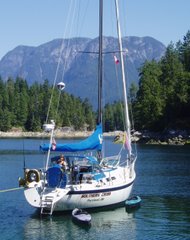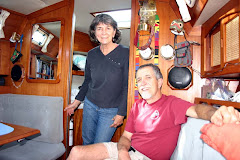We might have stayed longer at Makongai to snorkel among the giant clams, but we awoke to rain showers, so decided to push on. It was an easy sail to Naigani, where we anchored in "Picnic Cove" on the northeastern side of the island. We dinghied around to the other side of the island to visit the Naigani Island resort. We thought about doing a dive or an excursion to Ovalau from here, but the weather remained rather stinky, so the next morning we sailed on again, this time reaching Viti Levu, the largest island in Fiji. As we sailed north along the coast, we arrived at the rain shadow which makes the northern and western coasts so inviting to tourists.

Not only did it get sunnier, but smoother as well, as we passed into the protection of an extensive barrier reef. Glad there are a few channel markers along the way to keep us out of trouble. Most of them are just old iron rails like the one pictured here. Floating nav aids would be destroyed by cyclones on a regular basis.

Our next stop was the difficult to pronounce island of Nananu-i-ra. There are several small resorts here, and the diving is reputedly quite good, so we expected to see some other yachts here. But we had the place to ourselves the first night. The next day, a charter boat came into the bay, and one of the crew soon dinghied over to say hi. Peter asked us if we wanted any fresh fish, and proceeded to fillet out an entire mahi mahi for us! He wouldn't take anything for it, either; he just wanted a break from the boat and to have some conversation. Another example of the friendly welcome that has been extended to us wherever we go in this beautiful country.

Before leaving, we went ashore for a hike. We met a number of friendly locals, climbed a very gnarly tree, and saw some very nice vacation homes, mostly owned by Australians.


On our way back to the boat, we were invited in for tea by Jane and Charles. They divide their time between London, St. Martin in the Caribbean, and their recently acquired home here. That's a lot of travel! They also keep a sailboat in the Caribbean, and two more here! That's at least two boats too many, in my book.

The next morning we set out along the northern coast of Viti Levu. There was very little wind, as you can see from this picture. The smoke in the background is from a canefield being burned after harvest. From here west, we are in the land of sugar cane.

Following a recommendation from Jane, we stopped for the evening in the lee of a small motu. The water was like glass, perfectly reflecting the sunset.

The next day brought rain, but no wind, so we motored most of the way to Lautoka. Along the way, a tiny bird came aboard for a rest. It clung to the shrouds for awhile, then found a more comfortable perch on a ratline. It wasn't bothered when I came near to furl the sail. We tentatively identified it as a female red avadavat, yet another introduced species. As it finally flitted off toward Viti Levu, I marveled at how such a small bird could find its way so far from land, and back again. How, and why...?

Our next visit was from a colorful local fishing boat. We often get asked for cigarettes, lures, hooks, or other small items, but these guys only wanted to get close enough to snap our picture with their cell phone! Turned the tables on us tourists!

As we approached Lautoka, one of Fiji's largest cities, we decided to anchor across the channel from town, where we had a nice view of a 3-masted schooner and several other fine yachts anchored along the town front.

We dinghied across the channel and walked into town. Way more busy and crowded than Savusavu! It was a bit of a shock after 6 weeks in the outer islands. We had a nice Indian thali lunch before heading back to the boat.
 This is the fourth time we have laid our boat up for an extended period, and the third time we have left her on the hard. So we are no strangers to the work involved, and always on the lookout for ways to make the process easier. It was an easy decision to rent a modest cottage from Vuda Point marina, so that we could leave the mess behind at the end of each workday.
This is the fourth time we have laid our boat up for an extended period, and the third time we have left her on the hard. So we are no strangers to the work involved, and always on the lookout for ways to make the process easier. It was an easy decision to rent a modest cottage from Vuda Point marina, so that we could leave the mess behind at the end of each workday.
 The boat yard crew, headed by Mo, were very easy to work with, and very gentle with the Travelift. However, they did not heed my warning that we had a deep fin keel. Consequently, the Travelift had to wait while they dug the keel pit another foot deeper.
The boat yard crew, headed by Mo, were very easy to work with, and very gentle with the Travelift. However, they did not heed my warning that we had a deep fin keel. Consequently, the Travelift had to wait while they dug the keel pit another foot deeper.
 There are several people here who will look after your boat for you. We went with Mr. Bharos, a diminutive Indo-Fijian who had looked after our friends' boat Tomboy two seasons ago. He campaigned hard for our business, and we feel he will do a good job for us. He's already polished all the stainless.
There are several people here who will look after your boat for you. We went with Mr. Bharos, a diminutive Indo-Fijian who had looked after our friends' boat Tomboy two seasons ago. He campaigned hard for our business, and we feel he will do a good job for us. He's already polished all the stainless.
 So here is how we left her, in a hurricane pit with sails and canvas removed, but with a full cover in place to protect from sun and rain. Mr. Bharos assures us that he will remove the cover in the event of high winds, and re-install it afterwards.
So here is how we left her, in a hurricane pit with sails and canvas removed, but with a full cover in place to protect from sun and rain. Mr. Bharos assures us that he will remove the cover in the event of high winds, and re-install it afterwards.
 Our last night in Fiji, we had dinner at the First Landing restaurant next door to the marina. The local musicians sang us the traditional "Farewell Song."
Our last night in Fiji, we had dinner at the First Landing restaurant next door to the marina. The local musicians sang us the traditional "Farewell Song."
 It's been a wonderful seven weeks in Fiji. We look forward to another season here next year!
It's been a wonderful seven weeks in Fiji. We look forward to another season here next year!
















































